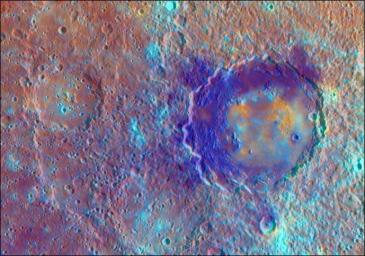
|
Dramatic Darks of Derain
- Click the image above for a larger view
- Full-Res JPEG (3005 x 2105) (840.2 kB)
- Full-Res TIFF (3005 x 2105) (19.0 MB)
Caption:
In this enhanced color view of the peak-ring basin Derain , the different colors accentuate the different rocks associated with the basin. The dramatic dark blue patches are comprised of low reflectance material perhaps excavated from depth by the impact event that formed the basin. The smooth, interior volcanic fill of the basin, in addition to the large pits on the floor of Derain, are brighter and redder. This view was created by draping a color composite from the MDIS Wide Angle Camera (WAC) over an MDIS monochrome Narrow Angle Camera (NAC) image mosaic. The WAC enhanced color image was created with the following image channels: red = Principal Component 2, green = Principal Component 1, and blue = 430 nm to 1000 nm band ratio.
Instrument:
Mercury Dual Imaging System (MDIS)
Latitude:
-9.0°
Longitude:
17.3° E
Scale:
Derain peak-ring basin has a diameter of 167 km (104 miles)
Background Info:
The MESSENGER spacecraft is the first ever to orbit the planet Mercury, and the spacecraft's seven scientific instruments and radio science investigation are unraveling the history and evolution of the Solar System's innermost planet. In the mission's more than four years of orbital operations, MESSENGER has acquired over 250,000 images and extensive other data sets. MESSENGER's highly successful orbital mission is about to come to an end , as the spacecraft runs out of propellant and the force of solar gravity causes it to impact the surface of Mercury in April 2015.
For information regarding the use of images, see the MESSENGER image use policy .
Cataloging Keywords:
| Name | Value | Additional Values |
|---|---|---|
| Target | Mercury | |
| System | ||
| Target Type | Planet | |
| Mission | MESSENGER | |
| Instrument Host | MESSENGER | |
| Host Type | Orbiter | |
| Instrument | Mercury Dual Imaging System (MDIS) | |
| Detector | Narrow Angle Camera (NAC), Wide Angle Camera (WAC) | |
| Extra Keywords | Color, Impact, Radio, Volcano | |
| Acquisition Date | ||
| Release Date | 2015-04-16 | |
| Date in Caption | ||
| Image Credit | NASA/Johns Hopkins University Applied Physics Laboratory/Carnegie Institution of Washington | |
| Source | photojournal.jpl.nasa.gov/catalog/PIA19412 | |
| Identifier | PIA19412 | |
